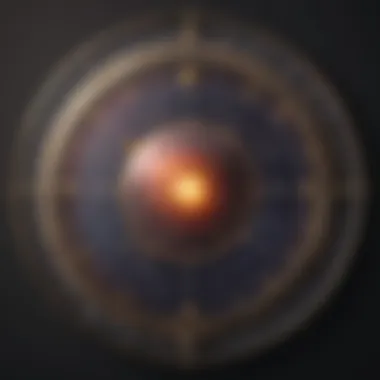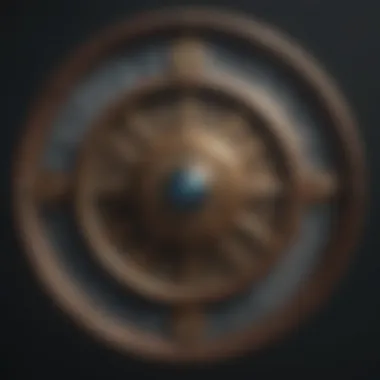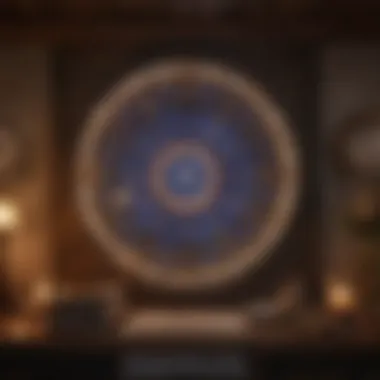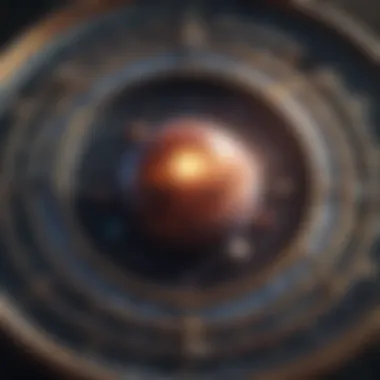Decoding the Meaning of Horoscope Charts


Intro
In the vast and intricate world of astrology, understanding horoscope charts can feel like navigating a maze. Each line drawn, every celestial body positioned, speaks volumes about the essence of who we are and how we relate to the universe. Essentially, your horoscope chart serves as a cosmic fingerprint—unique to each individual—crafted through the alignment of planets and stars at the time of your birth. This article aims to unravel the complexities of horoscope charts, providing insight that resonates not just with seasoned astrology buffs but also with curious novices eager to grasp the significance of their celestial alignments.
Astrology plays a pivotal role in many cultures, offering guidance on personal relationships, career paths, and self-reflection. It illustrates how planetary movements influence our everyday life, emotions, and decision-making processes. Readers will embark on a journey that explores various components of horoscope charts, from zodiac signs to planetary aspects. By understanding these elements, one can develop a clearer picture of personal attributes, strengths, and potential areas for growth.
The rolling theme of this article lays out essential sections that cover:
- A glimpse into zodiac signs and their traits
- An in-depth analysis of daily, weekly, and monthly predictions
- The impact of astrology on personal developement
Engaging with this topic enlightens individuals on how to maneuver through life's ups and downs with the knowledge of their horoscope. In the following sections, we will draw from essential astrological practices to show how one can pave the way to better decisions and personal growth.
Prolusion to Horoscope Charts
Understanding horoscope charts is akin to unearthing the blueprint of a soul's journey. These charts offer profound insights not only into an individual’s personality but also provide a unique perspective on the interconnectedness of life’s events. By dissecting and analyzing a horoscope chart, one can highlight various traits, preferences, and even challenges that arise, acting as a compass in the tumultuous sea of existence.
When approaching horoscope charts, one must first grasp what they intend to convey about a person’s essence and behavior. Each component within a chart—from planetary positions to the twelve distinct zodiac signs—tells a part of a larger story. This story shapes how we relate to others, tackle obstacles, and perceive ourselves.
Defining Horoscope Charts
A horoscope chart, at its core, is a celestial snapshot, depicting the positions of the sun, moon, and planets at the exact moment of a person's birth. This chart serves as a map of both potential and challenges, encapsulating the energies influencing an individual throughout their life. The intricacies of a chart can be daunting, yet they offer insights that are both illuminating and enriching.
From the angles of planets to the interplay of elements, every detail is significant. Consider, for instance, how a fire sign like Aries may influence a person’s assertiveness, contrasting sharply with the more subdued nature of a water sign like Pisces. This dynamic interplay helps individuals understand their motivations and reactions, helping to navigate life’s complexities with greater clarity.
Historical Perspectives
Astrology is not a mere modern construct; its roots stretch back into antiquity. Ancient civilizations, ranging from the Babylonians to the Egyptians, revered astrology as an essential tool for understanding the cosmos. They believed that the movements of celestial bodies echoed human life.
Archaeological remnants reveal that they utilized horoscope charts to plan agricultural activities, religious ceremonies, and even political strategies. As the centuries passed, astrology evolved. By the time of the Greeks, figures like Ptolemy synthesized existing knowledge, further shaping the methodology for interpreting horoscope charts that many still use today.
Modern Use in Astrology
In today’s world, astrology has blossomed into an intricate blend of art and science, finding a place in both popular and academic discourse. The accessibility of horoscope charts has propelled interest, as various online platforms and applications now cater to those seeking insight. No longer confined to the esoteric circle, individuals from various walks of life examine their charts for self-discovery.
Astrological practices have adapted to current contexts, often paralleling psychological theories. The insights derived from horoscope charts can indicate personal strengths, potential career paths, and relationship dynamics. People are increasingly using these cosmic blueprints to foster personal growth, suggesting a deepening recognition of the ways in which the universe shapes personal experience.
"The stars themselves are not a power, but a substance, giving me a sense of boundless possibility."
In essence, the study of horoscope charts today can guide individuals towards better self-awareness and encourage explorations of their unique life paths. As we journey through examining the components of horoscope charts and how to interpret them, we will unveil powerful insights into both personal and collective human experience.
Components of a Horoscope Chart
Understanding the components of a horoscope chart is like piecing together a cosmic puzzle. Each element plays a key role in shaping the overall picture, giving insights into personality traits, life challenges, and potential growth avenues. By exploring these components—such as zodiac signs, planetary positions, astrological houses, and aspects between celestial bodies—individuals can unlock their personal narratives written in the stars.
The Zodiac Signs
Overview of Zodiac Signs
The zodiac signs, representing different personality archetypes, are arguably the most recognizable aspect of astrology. Each sign, from Aries to Pisces, illustrates distinct characteristics and behaviors that people may exhibit based on their astrological birth chart. This familiarity with zodiac signs makes them particularly popular in discussions around horoscope meanings.
People resonate with the stereotypes associated with their signs. For instance, Geminis are often seen as adaptable and curious, while Capricorns may be considered disciplined and practical. This symbolic richness fosters a sense of identity and connection among astrologers and enthusiasts alike.
One unique feature of the zodiac signs is their elemental classification—fire, earth, air, and water. This classification shapes how the signs relate to each other and influences interpersonal dynamics. Understanding these patterns can be a beneficial tool in navigating social relationships, though it may lead to oversimplifications or clichés if not approached thoughtfully.


Influence of Each Sign
The influence of each zodiac sign extends far beyond mere personality descriptions. Each sign carries its rulership over specific areas of life. For instance, Venus rules Libra, imbuing it with themes of love and harmony. Understanding these influences can provide deeper insights into how each sign might manifest in personal circumstances.
The unique characteristics of these signs can help individuals identify potential strengths and weaknesses. For example, a Scorpio's intensity can fuel their passion but may also lead to conflict if mismanaged.
Recognizing these influences can guide personal development but can also create an overreliance on the traits associated with their sign, potentially stalling growth if individuals do not push beyond these boundaries.
Planetary Positions
The Role of Planets in Astrology
Planetary positions add another layer of intricacy to a horoscope chart. The planets are seen as energetic forces that affect various facets of human life. Each planet represents a distinct influence—Mars embodies action, while Venus resonates with love. Understanding where these planets sit in relation to the signs at birth enriches the interpretative process.
This aspect provides astrologers with the tools to delve into an individual’s inner workings, highlighting motivations behind their actions. By recognizing how these influences interplay, people can identify patterns that may be shaping their experiences, offering a roadmap for personal development.
It’s crucial, however, not to take the planetary roles as the sole determinants of life’s outcomes. The individual’s choices and environment also play a significant role, creating a fuller picture.
Effects of Different Planets
Not all planets exert the same effect, and their uniqueness is fascinating. For instance, the slow-moving Saturn often brings challenges that encourage growth, forming the backbone of many astrological discussions. On the other hand, quick-moving Mercury may influence day-to-day communication and thinking patterns.
This variety in planetary influence allows individuals to understand more about their life's ebb and flow, as well as their emotional responses. The consideration of how various planets interact can map a person's journey from youth to maturity—an invaluable perspective.
However, as enlightening as this can be, it can also lead to confusion if over-interpreted. Each planet must be seen in context with one another and the entire chart.
Astrological Houses
Understanding the Twelve Houses
Astrological houses represent different life areas, from relationships to career. Each house corresponds to parts of a person's life journey, holding significance based on the celestial bodies at the time of birth. The first house begins with the ascendant sign, indicating how one presents themselves to the world.
A key characteristic of the houses is their focus on the personal experience. Understanding where planets fall within these houses enables a more nuanced interpretation—reflecting how life events and external influences may manifest for an individual.
In this guide, awareness of the twelve houses can be a valuable asset for self-reflection, providing a mechanism to align one's priorities with their chart, though it could encourage an overly narrow view if too rigidly adhered to.
Significance of House Positions
The significance of house positions extends beyond mere categorization. Each planet that dwells within a house can highlight specific areas demanding attention. For example, if Mars resides in the seventh house of relationships, it might emphasize both passion and potential conflicts in partnerships.
This positioning can inform about the timing of events, revealing when challenges might arise or opportunities for growth present themselves. It’s insightful for strategizing personal and professional goals based on one's unique astrological landscape.
A downside could be an overemphasis on external circumstances. Individuals should balance understanding these house influences with their agency in shaping their lives, recognizing that empowerment comes from within regardless of cosmic placements.
Aspects Between Celestial Bodies
Types of Aspects
Aspects represent the angles that planets make to each other, dictating how their energies interact. They can enhance understanding or create tension, and their classification—conjunctions, squares, trines, and oppositions—provides a framework for interpreting these celestial conversations.
The unique feature about aspects is their capacity to create complex narratives. A strong trine may bring ease and harmony, while a square could ignite tensions that push for resolution. Understanding these dynamics can illuminate areas of conflict and creativity in a person’s life.
However, caution is advised not to view aspects too rigidly or deterministically. Life is nuanced, and so must interpretations be.
Interpretation of Aspects


Effective interpretation of aspects can be transformative. By assessing how these celestial conversations either support or challenge an individual, an astrologer can outline potential pathways to growth or diversion. This interpretation calls for a delicate touch—it's essential to acknowledge that while aspects reveal potentials, they do not dictate outcomes.
The beauty of interpreting aspects lies in their invitation to individuals to take responsibility for their journey. Harnessing the energies represented by these aspects may inspire personal transformations, providing a more comprehensive understanding of how to navigate life's complexities.
However, one must be careful to avoid becoming overly dependent on these interpretations, as life's outcomes are shaped by an intricate dance of choices, circumstances, and inherent agency.
Interpreting Your Horoscope Chart
When it comes to astrology, interpreting your horoscope chart is like opening a treasure chest of personal insights. It combines ancient wisdom with personal reflection, guiding seekers on a journey through the cosmic script written in celestial bodies. Each chart reflects a unique tapestry—crafted from the positions of the planets and signs at the exact moment of one's birth—which speaks volumes about potential paths and characteristics.
The importance of delving into this interpretation cannot be overstated. Engaging with your horoscope chart allows for a tailored understanding of who you are and can become. Rather than just a sunny forecast for your day, these interpretations provide a deeper analysis, highlighting patterns that may influence behavior, relationships, and career choices.
Deciphering Symbols and Signs
In this realm of symbols and signs, every detail counts. Each zodiac sign, planet, and house offers layers of meaning, just like a well-crafted novel where every chapter contributes to the whole. To decode a horoscope chart, one must familiarize themselves with the symbolic language astrology speaks.
Elements like the twelve zodiac signs provide significant insights. For instance, Aries, often associated with assertiveness, may indicate leadership qualities if prominent in the chart. Meanwhile, a strong presence of Pisces could suggest a creative and sensitive nature. Understanding these signs and their meanings is crucial in getting the most out of chart readings.
Personalizing Your Chart Reading
Strategies for Interpretation
Now, moving towards personalizing your chart reading, it becomes essential to develop strategies that can improve interpretation. Techniques such as focusing on major aspects in the chart, like conjunctions or oppositions, can be particularly beneficial. They unveil the dynamics between celestial bodies that may highlight key life areas. The beauty in this approach is its adaptability; it can cater to varying personal experiences, making it a popular choice among astrology enthusiasts.
The unique feature of this strategy lies in its emphasis on intuition. By coupling analytical skills with personal gut feelings, readers can glean insights that resonate more deeply with them, fostering a connection to their chart. However, one must tread carefully; over-reliance on intuition without grounding research may lead to inaccurate conclusions.
Common Pitfalls to Avoid
While personalizing the interpretation sounds great, it’s easy to stumble into common pitfalls. One prevalent error is taking aspects at face value without considering the entire chart context. For example, a planet in retrograde might signal a period of reflection, but other chart elements could alter its influence significantly. Recognizing the interconnectedness of various components in the chart is vital.
Another cautionary point is to avoid overly simplistic interpretations. Many people might pigeonhole characteristics into just one zodiac sign or planet, missing the richness of multiple influences. This strategy requires diligence and a broader perspective; keeping an open mind helps in recognizing the complex narratives across charts.
Utilizing Chart Insights for Growth
Gleaning insights from a horoscope chart isn't merely an intellectual exercise; it can foster personal growth. By applying a framework for self-reflection, individuals can navigate their lives more consciously.
Framework for Self-Reflection
This framework essentially promotes inquiry into one’s experiences and feelings as influenced by chart placements. Using the chart as a mirror can clarify emotional responses and patterns. For instance, someone with a strong Mercury influence might find engagement in communication vital, allowing for deeper exploration in social interactions.
This reflective practice encourages Astrology enthusiasts to take ownership of their lives, promoting actionable insights to build upon. However, it also comes with the challenge of vulnerability—facing one's tendencies can be daunting yet transformative.
Applying Insights in Everyday Life
Lastly, the way one applies these insights in everyday life can shape personal development significantly. By recognizing sun sign characteristics or exploring the influences of the moon and rising sign, individuals can adjust their daily interactions and choices. This practical aspect of astrology opens doors for conscious decision-making and aligns actions with personal values and goals.
The key here is cultivating a balance between understanding charts and integrating those insights into daily routines. It doesn’t just add a sprinkle of magic; it nurtures grounded personal growth that connects the celestial to the tangible, enriching everyday life experiences.
The Role of Transits and Progressions
The dynamic nature of life is often encapsulated beautifully through astrology, particularly regarding transits and progressions. These concepts can shed light on current and future events, providing insights that are particularly relevant to anyone seeking to understand how cosmic movements affect their personal lives. Understanding these elements adds another layer to our grasp of horoscope charts by revealing how they interact with the static positions of our natal charts.
Understanding Astrological Transits


Astrological transits occur when the current positions of the planets move in relation to your natal planets. Imagine the sky is a stage, and the planets are actors entering and exiting various scenes in your life's play. This interaction can spark significant shifts in your life, often correlating with events, moods, and insights.
For example, when Jupiter, the planet of expansion, forms a favorable aspect to your natal Sun, you may experience a surge in creativity, opportunities for growth, or simply an uplifting of spirits. Conversely, a challenging aspect from Saturn could bring obstacles, highlighting areas that need restructuring in your life.
It's essential to keep in mind that the influence of transits is not one-size-fits-all; everyone experiences them differently based on their individual natal chart. Timing becomes critical here. While Saturn might represent challenges, the period it influences you could also align with long-lasting personal growth if navigated wisely.
Progressions: A Deeper Look
Progressions, unlike transits that reflect external movements, are an internal mapping of your chart's evolution over time. They reveal the subtle shifts in your personality and outlook by advancing the natal chart forward, typically a day for each year of life. Mediating the natal positions helps to understand how experiences transform you as you age.
For instance, if your natal Moon was in Taurus and progressed to Gemini, you might find that your emotional responses and priorities shift from a focus on stability to a desire for communication and playfulness. This internal evolution is often a more profound and slow burn, influencing your personal narrative as you mature.
Their Impact on Personal Charts
The implications of transits and progressions are vast, as they create a calendar for your astrological journey.
- Timing life changes: Knowing when a significant transit is on the horizon can help you prepare for shifts in your personal or professional life.
- Personal growth: Progressions can illuminate how your attitudes, values, and desires evolve, encouraging self-reflection and growth.
- Relationships: Both transits and progressions can show how current influences might affect your interactions with others, helping to navigate complex dynamics.
Common Applications of Horoscope Charts
When delving into the world of astrology, one soon realizes that horoscope charts are not merely decorative pieces filled with intricate symbols. Instead, they serve as powerful tools that can offer valuable insights into various aspects of life. This section discusses some of the prevalent applications of horoscope charts, illustrating their relevance in personal relationships, career pathways, and navigating life's tumultuous waters.
In Personal Relationships
The intricate tapestry of interpersonal dynamics is often reflected in the energies and influences captured in horoscope charts. Every sign, house, and aspect plays a role in shaping how individuals relate to one another.
- Understanding Compatibility: Astrology enthusiasts frequently use their charts to explore compatibility. By comparing zodiac signs and the positions of celestial bodies, individuals can gain a deeper understanding of their bonds. For instance, a Scorpio may find that their intensity complements a Cancer’s nurturing nature, creating a potent emotional union.
- Communication Styles: Different signs have unique ways of expressing themselves. A fire sign like Aries might approach discussions with enthusiasm and passion, while an air sign, such as Gemini, prefers wit and intellect. Understanding these differences can help individuals bridge communication gaps in relationships.
- Conflict Resolution: Astrological insights can provide a fresh perspective on resolving conflicts. For example, knowing that a partner’s Mars is in a compatible house can offer insights into how they assert themselves in arguments. Identifying these patterns allows for better handling of disputes, fostering a healthier dialogue.
"Astrology doesn’t dictate your life; it merely offers a mirror to understand the different facets of your personality and relationships."
Career and Professional Growth
When individuals look at their horoscope charts, they often uncover paths that align with their innate skills and tendencies. Different planetary placements can indicate suitable careers that resonate with one's true self.
- Strengths and Weaknesses: Consider the Midheaven—the point in a chart that symbolizes one’s career trajectory. Its sign can help an individual identify their strengths and weaknesses in a professional environment. For instance, someone with a Capricorn Midheaven might excel in structured environments that require discipline.
- Timing for Career Moves: Astrology allows individuals to identify favorable times for change or new opportunities. Certain transits, such as Jupiter returning, indicate periods of growth and expansion, making them ideal for seizing career advancements.
- Workplace Relationships: Insights from a chart don’t just guide individual choices; they illuminate dynamics within workplace relationships. Knowing colleagues’ signs can help predict teamwork compatibility and project outcomes.
Navigating Life Challenges
Life is full of ups and downs, and the guidance of horoscope charts can be a beacon during challenging times. People often turn to astrology for clarity and direction when confronted with difficulties.
- Coping Mechanisms: Charts can reveal how individuals might naturally cope with stress, providing tools for self-care. For instance, a Taurus might benefit from grounding techniques, while a Sagittarius might find solace in exploration and new experiences.
- Life Lessons: Each sign brings unique challenges corresponding with their traits. Recognizing these traits can help individuals confront and learn from their struggles rather than feel overwhelmed. For example, a Leo may grapple with self-confidence issues, which they can tackle through creative self-expression.
- Long-term Planning: Understanding planetary cycles can lead to informed decision-making. Recognizing when a challenging transit is set to end can offer hope and motivate individuals to push through tough periods.
Ultimately, the applications of horoscope charts are vast and multifaceted, serving as invaluable guides throughout various life experiences. By comprehending and integrating these astrological insights, individuals can cultivate richer relationships, thrive in their careers, and navigate life's hurdles with greater ease.
Finale: Embracing Your Horoscope Chart
As we reach the culmination of our exploration into horoscope charts, it's crucial to underscore the importance of fully embracing these celestial narratives. Horoscope charts are not merely a collection of symbols and lines; they are intricate maps that can guide us toward deeper self-understanding and personal growth. Each chart, unique to the individual, serves as a mirror that reflects both the potential and challenges that lie within. By tapping into the insights that these charts offer, individuals can navigate the complexities of their lives with greater awareness and intention.
Integration of Astrological Insights
Integrating astrological insights into daily life can be a transformative experience. When one learns to interpret their horoscope chart, it becomes evident that astrology is more than fortune-telling. It's a tool for introspection. Consider the following aspects:
- Recognizing patterns: By observing recurring themes in your chart, you can identify patterns in your behavior and relationships, allowing for more informed decisions.
- Timing life events: Awareness of celestial movements can help align personal actions with favorable astrological periods.
- Self-reflection: Every planet and sign brings distinct traits. Reflecting on these can spur personal growth, urging you to harness strengths and acknowledge weaknesses.
"Understanding your horoscope chart is like having a compass in the vast ocean of life."
Continued Exploration and Study
Astrology is a field ripe for continued exploration and lifelong learning. The universe is vast, and so too are the intricacies embedded within horoscope charts. Each layer of knowledge builds upon the last, offering a richer understanding over time. Here are a few pointers for those looking to delve deeper:
- Read books and articles on astrology from various perspectives for a broader understanding.
- Engage with communities, such as those on Reddit or Facebook, where discussions can spark new insights.
- Consult with professional astrologers for personalized readings that can enhance your comprehension of complex themes in your chart.
- Practice, practice, practice. The more you draw and interpret charts, the more adept you'll become at spotting connections.







